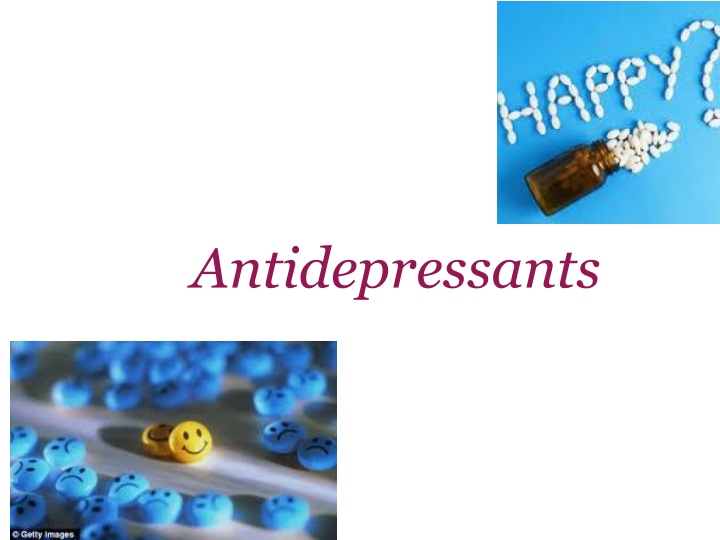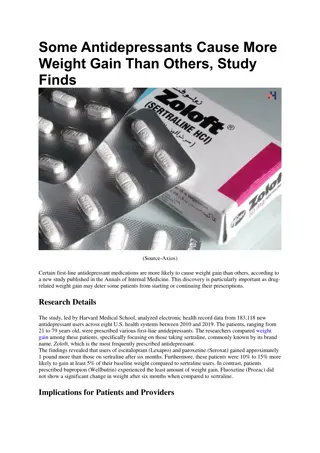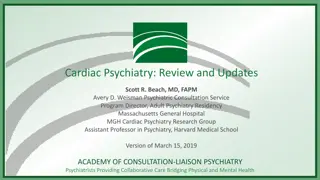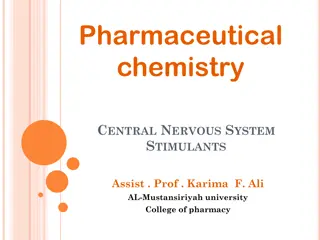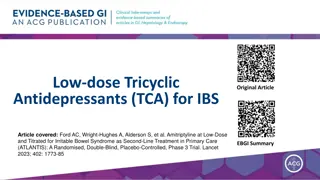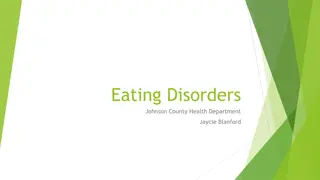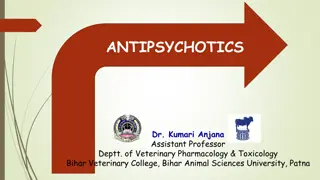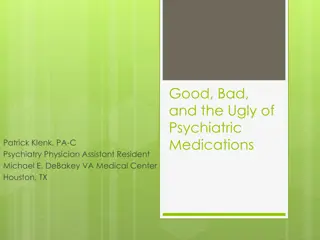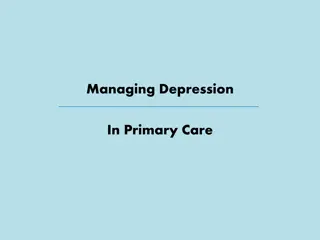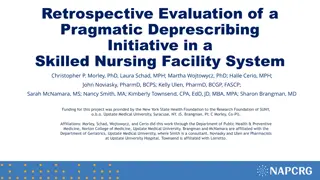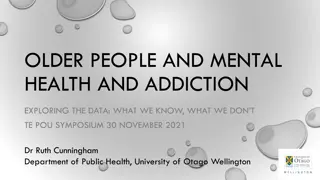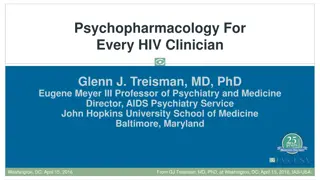Antidepressants
Antidepressants are medications used to treat depression and other mental health conditions. They work by affecting neurotransmitters in the brain, specifically serotonin and norepinephrine. The monoamine hypothesis of depression suggests that a deficiency in these neurotransmitters is linked to depression. Selective serotonin reuptake inhibitors (SSRIs) are a common type of antidepressant that target serotonin levels. These medications can take up to 2 weeks to show improvement in mood and are used to treat various disorders including depression, anxiety, and bulimia nervosa.
Download Presentation

Please find below an Image/Link to download the presentation.
The content on the website is provided AS IS for your information and personal use only. It may not be sold, licensed, or shared on other websites without obtaining consent from the author.If you encounter any issues during the download, it is possible that the publisher has removed the file from their server.
You are allowed to download the files provided on this website for personal or commercial use, subject to the condition that they are used lawfully. All files are the property of their respective owners.
The content on the website is provided AS IS for your information and personal use only. It may not be sold, licensed, or shared on other websites without obtaining consent from the author.
E N D
Presentation Transcript
Antidepressants Depression: feelings of sadness & hoplessness, as well as, inability to experience pleasure in usual activities, changes in sleep patterns & appetite, loss of energy & suicidal thoughts Mania (opposite behavior):enthusiasm, anger, rapid thought & speech patterns, extreme self-confidence, & impaired judgment Biogenic amine theory???
Monoamine Hypothesis of Depression Depression is related to a deficiency in the amount or functionof cortical and limbic serotonin (5-HT), norepinephrine (NE), and dopamine (DA). Evidence to support, ----Reserpine????
MECHANISM OF ANTIDEPRESSANT DRUGS Antidepressant drugs potentiate, either directly or indirectly, the actions of NE &/or 5-HT in the brain The biogenic amine theory Mania is caused by an overproduction of these neurotransmitters.
Selective serotonin Reuptake Inhibitors (SSRIs) Higher selectivity to 5-HT (3000 x 5-HT> NE) low activity on M, H1, -adrenergic?? Replaced TCA & MAOIs Fluoxetine, Citalopram, Escitalopram, Fluvoxamine, Paroxetine, Sertaline
Therapeutic Uses Depression Obsessive-compulsive disorder Panic disorder Generalised anxiety disorder Premenstrual dysphoric disorder Bulimia nervosa
Pharmacokinetics Well absorbed orally, 2-8 hrs., t1/2=16-36 hrs Food, sertaline??? Hepatic metabolism Fluoxetine (S-norfluoxetine), sustained prep. Fluoxetine & paroxetine inhibitors of CYP2D6 / TCA CYP2C9/19, CYP3A4 / SSRI???
Adverse Effects Headache, sweating, anxiety, agitation GIT disturbances (NVD) Weakness, fatigue, sleep disturb. Drug-Drug interaction Hyponatremia
Sleep disturbance paroxetine, fluvoxamine / sedating fluoxetine, sertaline / activating Sexual Disturbance libido, delayed ejaculation, anorgasmia (change or move to bupropion, mirtazapine) Use in Children & Teenagers (1/50 suicidal ideation) fluoxetine, sertaline, fluvoxamine / obsessive disorders fluoxetine, escitalopram / childhood depression
Overdose No cardiac arrhythmias, with the exception of citalopram, which may cause QT prolongation Seizures are a possibility because ????? SSRIs have the potential to cause serotonin syndrome, especially when used in the presence of an MAOI or other highly serotonergic drug Serotonin syndrome may include: hyperthermia, muscle rigidity, sweating, myoclonus (clonic muscle twitching), and changes in mental status and vital signs
Discontinuation syndrome Mainly the agents with shorter t1/2and inactive metabolites Fluoxetine has the lowest risk of causing an SSRI discontinuation syndrome due to its longer half-life and active metabolite Possible signs and symptoms of SSRI discontinuation syndrome include: headache, malaise and flu-like symptoms, agitation and irritability, nervousness, and changes in sleep pattern
Serotonine/Norepinephrine Reuptake Inhibitors (SNRI) Venlafaxine, Desvenlafaxine, Levomilnacipran, & Duloxetine potent inhibitor (at med., & high doses) treating depression in patients are not responding to SSNRIs little activity at -adrenergic, M or H Rs Both SNRIs & TCAs relieve pain used in the treatment of pain syndromes, such as diabetic peripheral neuropathy, postherpetic neuralgia, fibromyalgia, and low back pain SE: N,headache sexual dysfunction, increase HR & BP
Venlafaxine: is a potent inhibitor of 5-HT and, at medium to higher doses, is an inhibitor of NE reuptake minimal inhibition of the CYP450 isoenzymes and is a substrate of the CYP2D6 isoenzyme Desvenlafaxine: is the active, demethylated metabolite of venlafaxine. The most common side effects of venlafaxine are nausea, headache, sexual dysfunction, dizziness, insomnia, sedation, and constipation At high doses, there may be an increasein blood pressure and heart rate.
Duloxetine inhibits 5-HT & NE reuptake at alldoses. It is extensively metabolized in the liver to inactive metabolites GI side effects, nausea, dry mouth, and constipation, insomnia, dizziness, somnolence, sweating, and sexual dysfunction may increase blood pressure or heart rate. is a moderate inhibitor of CYP2D6 isoenzymes and may increase concentrations of drugs metabolized by this pathway, such as antipsychotics.
Atypical antidepressants Mixed group of agents (bupropion, mirtazapine, nefazodone, trazodone, vilazodone and vortioxetine) Bupropion weak DA & NE reuptake inhibitor used to decrease craving & attenuating withdrawal symptom in patients trying to quit nicotine SE: dry mouth, sweating, nervousness, tremor, and dose dependent increased risk for seizures. very low incidence of sexual dysfunction metabolized by the CYP2B6 pathway relatively low risk for drug drug interactions??? inhibit CYP2D6 should be avoided in patients at risk for seizures & who have eating disorders such as bulimia
Mirtazapine (enhances 5-HT & NE transmission) antagonist to presynaptic 2 to 5-HT2 R No antiM, SE Marked sedation??? Increase appetite & weight Nefazadone & Trazadone weak inhibitors of 5-HT reuptake block postsynaptic 5-HT 2 Sedative (H1 blocking effect), hepatotoxicity (nefazodone) Trazadone / off label / insomnia / priapism (persistent and painful erection of the penis) 1 antagonist?????
Vilazodone Serotonin reuptake inhibitor & a 5-HT1a receptor partial agonist it is unique from that of the SSRIs The adverse effect profile is similar to the SSRIs, including a risk for discontinuation syndrome if abruptly stopped.
Vortioxetine A combination of 5-HT reuptake inhibition, HT1a agonism, and 5-HT3 and 5 -HT7 antagonism The common adverse effects include nausea, constipation, and sexual dysfunction, which may be expected due to its serotonergic mechanism
Tricyclic Antidepressants Block 5-HT & NE Amitriptyline, imipramine, doxepin, clomipramine (3 amine) Nortriptyline, desipramine (2 amine) Maprotyline, amoxapen (tetracyclic) Mechanism of Action: TCAs and Amoxapine are potent SNRIs Maprotiline & Desipramine are relatively selective inhib. of NE reuptake. block 5-HT, -adrenergic, H receptors & M receptors Amoxapine also blocks 5-HT2 & DA 2 receptors
Therapeutic Uses Used for moderate to severe depression & panic disorders Imipramine / bed-wetting in children / vasopressin / enuresis alarm Amitriptyline / prevent migraines / chronic pain syndrome Low doses (Doxeoin)/ insomnia
Tricyclic Antidepressants Well absorbed orally / lipophilic /CNS widely distributed Hepatic metabolism (microsomal system), glucuronide conj / urine
Side Effects of TCAs Muscarinic blockade Alpha adrenergic block H1 blockade Weight gain Lower sexual dysfunction caution with patient with mania Narrow TI Excacerbate benign prostatic hyperplasia, epilepsy, and preexisting arrhythmias.
Drug-Drug Interactions
Mononamin Oxidase Inhibitors Phenelzine, tranylcypromine, selegeline, isocarboxazide
Mononamin Oxidase Inhibitors irreversible or reversible complex act centrally & peripherally effect is delayed several wks (2) phenelzine, tranylcypromine , isocarboxazid & Selegiline Limited use / complexity used for persons who are unresponsive to TCA well abs. orally Drug-food interaction (tyramine) hypertensive crisis,, headache, stiff neck, - - - phentolamine & prazocin used to treat tyramine induced
Mononamin Oxidase Inhibitors (cont.) Mostly, form stable complexes with the enzyme, causing irreversible inactivation (accumulation of NE, 5-HT & DA), e.g. Phenelzine Brain, GIT & liver ( catalyzes oxidative deamination of drugs and potentially toxic substances, such as tyramine) High incidence of drug drug and drug food interactions Selegiline / transdermal patch may produce less inhibition of gut and hepatic MAO at low doses because it avoids first-pass metabolism. Response delayed for several weeks Selegiline and tranylcypromine have an amphetamine-like stimulant effect that may produce agitation or insomnia.
Therapeutic uses Pharmacokinetics Adverse effects drug food and drug drug interactions hypertensive crisis, with signs and symptoms such as occipital headache, stiff neck, tachycardia, nausea, hypertension, cardiac arrhythmias, seizures and, possibly, stroke. Phentolamine and prazosin drowsiness, orthostatic hypotension, blurred vision, dry mouth, and constipation. CI: combination with other antidepressants
Treatment of Mania & Bipolar Disorder Lithium for acute & prophylaxis low TI Unknown mechanic SE: headache, dry mouth, polyuria, poldepsia, tremor, - - etc SE due to high doses: ataxia, slurred speech, tremor, confusion, convulsion Thyroid function may be decreased and should be monitored
Other Drugs for Mania & Bipolar Several antiepileptic drugs, e.g. carbamazepine, valproic acid, and lamotrigine are approved (chlorpromazine and haloperidol) and newer antipsychotics Atypical antipsychotics risperidone, olanzapine,ziprasidone, aripiprazole, asenapine, cariprazine Quetiapine, lurasidone, and the combination of olanzapine and fluoxetine have been approved for bipolar depression
